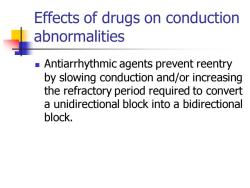吉林大学:《药理学》课程PPT教学课件(七年制)Antiarrhythmic drugs

Antiarrhythmic drugs
Antiarrhythmic drugs

OVERVIEW the heart contains specialized cells that exhibit automaticity,that is,they can intrinsically generate rhythmic action potentials in the absence of external stimuli
OVERVIEW ◼ the heart contains specialized cells that exhibit automaticity, that is, they can intrinsically generate rhythmic action potentials in the absence of external stimuli

INTRODUCTION TO THE ARRHYTHMIAS cardiac arrhythmias may cause the heart ■ (1)to beat too slowly (sinus bradycardia); (2)to beat too rapidly (sinus or ventricular tachycardia,atrial or ventricular premature depolarization,atrial flutter); (3)to respond to impulses originating from sites other than the SA node; (4)to respond to impulses traveling along accessory (extra)pathways that lead to deviant depolarizations (A-V reentry)
INTRODUCTION TO THE ARRHYTHMIAS ◼ cardiac arrhythmias may cause the heart ◼ (1) to beat too slowly (sinus bradycardia); ◼ (2) to beat too rapidly (sinus or ventricular tachycardia, atrial or ventricular premature depolarization, atrial flutter); ◼ (3) to respond to impulses originating from sites other than the SA node; ◼ (4) to respond to impulses traveling along accessory (extra) pathways that lead to deviant depolarizations (A-V reentry)

Causes of arrhythmias Abnormal automaticity:The SA node shows the fastest rate of Phase 4 depolarization if cardiac sites other than the SA node show enhanced automaticity,they may generate competing stimuli
Causes of arrhythmias ◼ Abnormal automaticity: The SA node shows the fastest rate of Phase 4 depolarization ◼ if cardiac sites other than the SA node show enhanced automaticity, they may generate competing stimuli

Effect of drugs on automaticity Most of the antiarrhythmic agents suppress automaticity (1)by decreasing the slope of Phase 4 (diastolic)depolarization (2)by raising the threshold of discharge to a less negative voltage
Effect of drugs on automaticity ◼ Most of the antiarrhythmic agents suppress automaticity ◼ (1) by decreasing the slope of Phase 4 (diastolic) depolarization ◼ (2) by raising the threshold of discharge to a less negative voltage

Abnormalities in impulse conduction Impulses from higher pacemaker centers are normally conducted down pathways that bifurcate to activate the entire ventricular surface .A phenomenon called reentry can occur if a unidirectional block caused by myocardial injury or a prolonged refractory period results in an abnormal conduction pathway
Abnormalities in impulse conduction ◼ Impulses from higher pacemaker centers are normally conducted down pathways that bifurcate to activate the entire ventricular surface .A phenomenon called reentry can occur if a unidirectional block caused by myocardial injury or a prolonged refractory period results in an abnormal conduction pathway

Effects of drugs on conduction abnormalities Antiarrhythmic agents prevent reentry by slowing conduction and/or increasing the refractory period required to convert a unidirectional block into a bidirectional block
Effects of drugs on conduction abnormalities ◼ Antiarrhythmic agents prevent reentry by slowing conduction and/or increasing the refractory period required to convert a unidirectional block into a bidirectional block

Antiarrhythmic drugs the antiarrhythmic drugs can modify impulse generation and conduction
Antiarrhythmic drugs ◼ the antiarrhythmic drugs can modify impulse generation and conduction

Classification Mechanism of Action Comment of Drug A Na channel blocker Slows Phase 0 depoiarizatlon B Nachannel blocker Shortens Phase 3 repoiarization IC Natchannei biocker Markediy siows Phase 0 depoiarization B Adrenoreceptor biocker Suppresses Phase 4 depoiarization K*channei blocker Prolongs Phase 3 repolarization IV Ca+channei blocker Shortens action potential

CLASS I ANTIARRHYTHMIC DRUGS Class I antiarrhythmic drugs act by blocking voltage-sensitive sodium channels Class I antiarrhythmic drugs therefore generally cause a decrease in excitability and conduction velocity
CLASS I ANTIARRHYTHMIC DRUGS ◼ Class I antiarrhythmic drugs act by blocking voltage-sensitive sodium channels ◼ Class I antiarrhythmic drugs therefore generally cause a decrease in excitability and conduction velocity
按次数下载不扣除下载券;
注册用户24小时内重复下载只扣除一次;
顺序:VIP每日次数-->可用次数-->下载券;
- 吉林大学:《药理学》课程PPT教学课件(七年制)Diuretic Drugs.ppt
- 吉林大学:《药理学》课程PPT教学课件(七年制)Opioid Analgesics and Antagonists.ppt
- 吉林大学:《药理学》课程PPT教学课件(七年制)Drugs Affecting the Respiratory System.ppt
- 吉林大学:《药理学》课程PPT教学课件(七年制)Drugs Affecting Blood.ppt
- 吉林大学:《药理学》课程PPT教学课件(七年制)Treatment of Congestive Heart Failure.ppt
- 吉林大学:《药理学》课程PPT教学课件(七年制)Macrolides(Erythromycin).ppt
- 吉林大学:《药理学》课程PPT教学课件(七年制)Drugs Used to Treat Epilepsy.ppt
- 吉林大学:《药理学》课程PPT教学课件(七年制)Antianginal Drugs.ppt
- 吉林大学:《药理学》课程PPT教学课件(七年制)Anticancer Drug.ppt
- 吉林大学:《药理学》课程PPT教学课件(七年制)Anti hypertensive Drugs.ppt
- 吉林大学:《药理学》课程PPT教学课件(七年制)Anxiolytic and hypnotic drugs.ppt
- 吉林大学:《药理学》课程PPT教学课件(七年制)Neuroleptic drugs.ppt
- 吉林大学:《药理学》课程PPT教学课件(七年制)Treatment of Parkinson’s disease.ppt
- 吉林大学:《药理学》课程PPT教学课件(七年制)Antidepressant drugs.ppt
- 吉林大学:《药理学》课程PPT教学课件(七年制)Antimicrobial Agents - General Consideration.ppt
- 吉林大学:《药理学》课程PPT教学课件(七年制)β-Lactam Antibiotics.ppt
- 吉林大学:《药理学》课程PPT教学课件(七年制)Chemotherapeutic Medicine.ppt
- 吉林大学:《药理学》课程PPT教学课件(七年制)Antituberculous drug.ppt
- 吉林大学:《药理学》课程PPT教学课件(七年制)The autonomic nervous system.ppt
- 吉林大学:《药理学》课程PPT教学课件(七年制)Introduction to Pharmacology.ppt
- 《药理学》课程教学资源(讲义)药理学步进教程(共四十九章).docx
- 石河子大学:《药理学》课程教学资源(教案,共二十八讲).docx
- 《药理学》课程教学资源(讲义)第一篇 药理学总论.pdf
- 《药理学》课程教学资源(讲义)第二篇 传出神经系统药理.pdf
- 《药理学》课程教学资源(讲义)第三篇 中枢神经系统药理.pdf
- 《药理学》课程教学资源(讲义)第四篇 心血管药理.pdf
- 《药理学》课程教学资源(讲义)第五篇 内脏药理.pdf
- 《药理学》课程教学资源(讲义)第六篇 内分泌药理.pdf
- 《药理学》课程教学资源(讲义)第七篇 化疗药物.pdf
- 《药理学》课程教学资源(实验指导)实验二 常用实验动物的捉拿固定和给药方法.pdf
- 《药理学》课程教学资源(实验指导)实验三 不同剂量、不同给药途径、不同机能状态对药物作用的影响.pdf
- 《药理学》课程教学资源(实验指导)实验四传出神经系统药理实验.pdf
- 《药理学》课程教学资源(实验指导)实验五传出神经系统药物对离体肠管的作用.pdf
- 《药理学》课程教学资源(实验指导)实验六局部麻醉药实验.pdf
- 《药理学》课程教学资源(实验指导)实验七 中枢神经系统药理实验.pdf
- 《药理学》课程教学资源(实验指导)实验八 镇痛药和解热镇痛药实验.pdf
- 《药理学》课程教学资源(实验指导)实验十 药物对离体兔心的作用.pdf
- 《药理学》课程教学资源(实验指导)实验十一抗心绞痛药实验.pdf
- 《药理学》课程教学资源(实验指导)实验十二 呋噻米对家兔的利尿作用.pdf
- 《药理学》课程教学资源(实验指导)实验十三 消化系统药物对家兔肠管的影响.pdf
